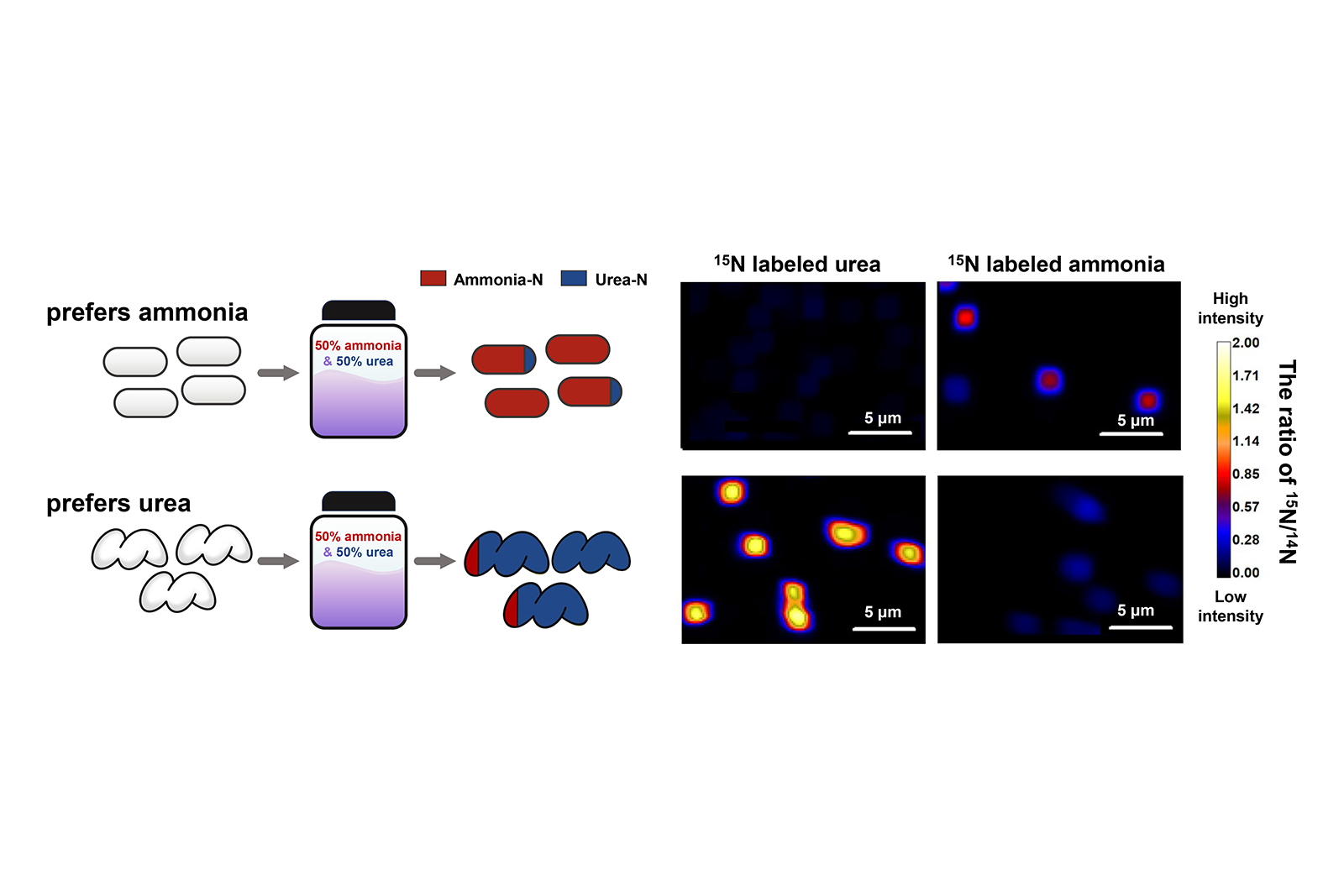February 12, 2024
Research about ammonia-oxidizing microorganisms reshapes our perspective on their physiology and ecological niche.

Stable isotope tracing followed by high-resolution imaging quantified preference for ammonia and urea nitrogen by two different AOM organisms (one that prefers ammonia and one that prefers urea). Data show high-resolution isotope maps of single microbial cells incubated with 15 N labeled urea or ammonia and were collected using the state-of-the-art NanoSIMS instrument (Nanoscale Secondary Ion Mass Spectrometry) at Lawrence Livermore National Laboratory.
In a recent research article published in Nature Microbiology, a team of researchers from the UW, along with collaborators from several other institutions have provided new insights into the physiology of ammonia-oxidizing microorganisms, commonly called AOM. Their findings, originating from observations made with a microbe isolated from Seattle's Green Lake, offer a new perspective on ammonia oxidation, a critical component of the global nitrogen cycle, and have implications for the management of nitrogen pollutants.
The study involved current and former members of CEE faculty Mari Winkler and Dave Stahl’s research group: Wei Qin, Stephany Wei, Britt Abrahamson, Zach Flinkstrom and Kristopher Hunt. Their research reexamines long-held beliefs about ammonia oxidation, focusing on how different AOM species utilize inorganic (ammonia) and organic (urea) nitrogen when both are available in the environment.
AOM use ammonia as an energy source while converting it to nitrite in a biogeochemical process called nitrification. Nitrification is a vital component in the global nitrogen cycle and accounts for the annual oxidation of approximately 2.3 trillion kilograms of nitrogen in marine, soil, freshwater, subsurface and man-made ecosystems. One major question that has remained unanswered for decades is how different species of AOM coexist in the same environment: do they compete for ammonia or instead use alternative compounds for their energy needs?
“Different lineages of AOM are known to grow in the same environment simultaneously and were thought to primarily compete for ammonia,” Wei says. “Our collaborative research focused on determining how these metabolically conserved lineages might coexist without direct competition for inorganic nitrogen (ammonia) by examining their ability to use organic nitrogen (urea) in the presence of ammonia.”
Urea is a widely available nitrogen compound in soil and aquatic environments and accounts for about 40 percent of all nitrogen in fertilizers. More than half of AOM species are capable of utilizing urea as an alternative energy source. However, additional energy is required to break urea down into ammonia before further utilization. Knowing this, the UW team and collaborators from the University of Oklahoma, University of Florida, Lawrence Livermore National Laboratory and Princeton sought to understand how different lineages of AOM utilize ammonia and urea when both are available simultaneously.
“We always thought urea was an alternative substrate to ammonia for all AOM species. Now, we realize that a major lineage of AOM actually prefer urea over ammonia and represses the use of ammonia when urea is present,” Abrahamson says. “Our first observation of this unique physiology was made with a strain isolated from sediment collected from Green Lake in Seattle. It is amazing that a microbe isolated from a Seattle park led to a discovery that challenges dominant assumptions that had persisted for more than 100 years since the cultivation of the first AOM species.”
Using nitrogen isotopes, the team conducted careful experiments with AOM isolates from major AOM lineages, and quantified the nitrogen flux from ammonia and urea into different gas, liquid and cellular components. Their findings show that different AOM lineages employ distinct strategies for controlling ammonia and urea utilization, thereby minimizing direct competition with one another and allowing for coexistence. These differential preferences reveal a hidden physiological biodiversity of this globally important functional group that requires further investigation.
This research has unearthed a fascinating aspect of the nitrogen cycle: AOM have the ability to preferentially utilize different nitrogen sources, and a major AOM lineage preferentially utilize urea over ammonia. This finding is crucial because substrate preferences determine how AOM interact within the environment and could influence the contribution of AOM to nitrogen pollution.
While AOM species help provide plants with the nitrate needed for growth, there are also downsides to this process. Flinkstrom points out, "AOM contribute to nitrate leaching in surface and groundwater, which promotes eutrophication, a process that leads to excessive plant growth, harmful algal blooms and hypoxic waters that kill local fish populations."
Flinkstrom also mentions, “AOM are involved in producing nitrous oxide, a greenhouse gas with a warming potential approximately 270 times greater than carbon dioxide over a 100-year timescale. The aerobic conditions of agricultural soils actually promote AOM-derived nitrous oxide emissions, resulting in the annual production of 5.4 million tons of nitrous oxide, which equates to about 3% of all greenhouse gas emissions.”
The discovery that an AOM lineage has a preference for urea—a common component in fertilizers—over ammonia provides a new perspective on how to potentially approach the reduction of nitrogen pollutants.
"With our insights into the AOM lineages that prefer urea, we could investigate their contribution to nitrate leaching and greenhouse gas production in the environment. Understanding these contributions is key to developing effective strategies for managing nitrogen pollution in both natural and engineered ecosystems," Flinkstrom says.
The team's future work will likely focus on exploring the environmental impact of these AOM lineages, especially those favoring urea, to create more effective solutions for reducing nitrogen-based pollution.
About this project
This project represents the collaborative effort of 13 authors from the Civil and Environmental Engineering Department at the University of Washington alongside authors from the University of Oklahoma (Qin lab, Zhou lab), the University of Florida (Martens-Habbena lab), Lawrence Livermore National Laboratory, Princeton University (Ward lab), Xiamen University, and Nanjing Agricultural University. This work was supported by grants from the U.S. Department of Energy’s Office of Science, Division of Biological and Environmental Research, the Defense Advanced Research Projects Agency, the Department of Agriculture National Institute of Food and Agriculture, Simons Foundation, the National Natural Science Foundation of China, and others.